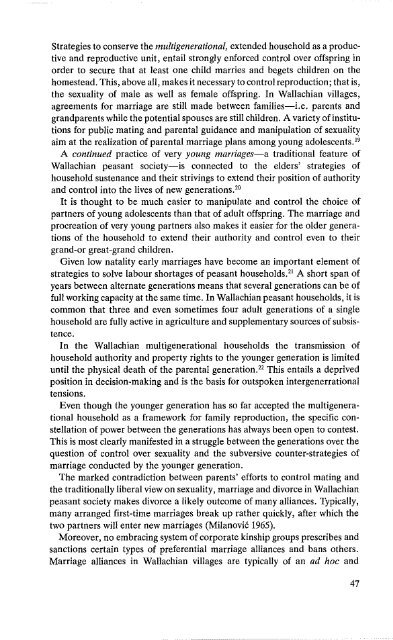Will they still be dancing? (1982)
Etnographic study of Romanians from East Serbia in Sweden in 1980s
Etnographic study of Romanians from East Serbia in Sweden in 1980s
Create successful ePaper yourself
Turn your PDF publications into a flip-book with our unique Google optimized e-Paper software.
Strategies to conserve the multigenerational, extended household as a productive<br />
and reproductive unit, entail strongly enforced control over offspring in<br />
order to secure that at least one child marries and <strong>be</strong>gets children on the<br />
homestead. This, above all, makes it necessary to control reproduction; that is,<br />
the sexuality of male as well as female offspring. In Wallachian villages,<br />
agreements for marriage are <strong>still</strong> made <strong>be</strong>tween families-i.e. parents and<br />
grandparents while the potential spouses are <strong>still</strong> children. A variety ofinstitutions<br />
for public mating and parental guidance and manipulation of sexuality<br />
aim at the realization of parental marriage plans among young adolescents.I'<br />
A continued practice of very young marriages-a traditional feature of<br />
Wallachian peasant society-is connected to the elders' strategies of<br />
household sustenance and their strivings to extend their position of authority<br />
and control into the lives of new generations. 20<br />
It is thought to <strong>be</strong> much easier to manipulate and control the choice of<br />
partners of young adolescents than that of adult offspring. The marriage and<br />
procreation of very young partners also makes it easier for the older generations<br />
of the household to extend their authority and control even to their<br />
grand-or great-grand children.<br />
Given low natality early marriages have <strong>be</strong>come an important element of<br />
strategies to solve labour shortages of peasant households. 21 A short span of<br />
years <strong>be</strong>tween alternate generations means that several generations can <strong>be</strong> of<br />
full working capacity at the same time. In Wallachian peasant households, it is<br />
common that three and even sometimes four adult generations of a single<br />
household are fully active in agriculture and supplementary sources of subsistence.<br />
In the Wallachian multigenerational households the transmission of<br />
household authority and property rights to the younger generation is limited<br />
until the physical death of the parental generation." This entails a deprived<br />
position in decision-making and is the basis for outspoken intergenerrational<br />
tensions.<br />
Even though the younger generation has so far accepted the multigenerational<br />
household as a framework for family reproduction, the specific constellation<br />
ofpower <strong>be</strong>tween the generations has always <strong>be</strong>en open to contest.<br />
This is most clearly manifested in a struggle <strong>be</strong>tween the generations over the<br />
question of control over sexuality and the subversive counter-strategies of<br />
marriage conducted by the younger generation.<br />
The marked contradiction <strong>be</strong>tween parents' efforts to control mating and<br />
the traditionally li<strong>be</strong>ral view on sexuality, marriage and divorce in Wallachian<br />
peasant society makes divorce a likely outcome of many alliances. Typically,<br />
many arranged first-time marriages break up rather quickly, after which the<br />
two partners will enter new marriages (MilanoviC 1965).<br />
Moreover, no embracing system of corporate kinship groups prescri<strong>be</strong>s and<br />
sanctions certain types of preferential marriage alliances and bans others.<br />
Marriage alliances in Wallachian villages are typically of an ad hoc and<br />
47
















